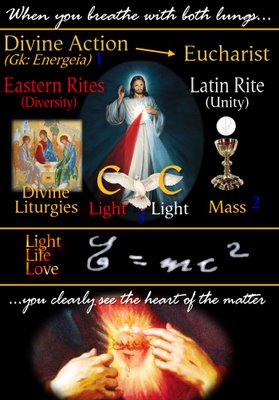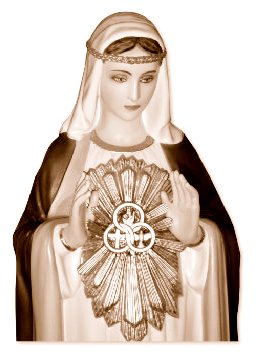J.M.J. + O.B.T. + M.G.R.*
This rainbow ceramic
plate image came from
Polish Gdansk
This is what I found when I continued the search:
First Report on the
Danzig Halo Display
by Mark Vornhusen

Hevels Zeichnung des Phänomens;
aus Pernter "Meteorologische Optik", 1. Aufl. 1906
The Danzig halo display on February 20, 1661, is probably the
most famous of all halo displays and is vividly discussed even nowadays.
It was observed by the excellent astronomer Johannes Hevelius, who describes
the phenomenon in his book “Mercurius in Sole visus “ with a
drawing. A reproduction of this drawing can be found in almost every book
dealing with halos. The special thing in this display is the observation
of fragments of a 90°-halo around the sun, with sundogs visible at its
points of intersection with the parhelic circle. The existence of these
halos could not have been proved by unmistakable photographs up to now.
There is also no theoretical explanation. So it is often supposed that Hevelius´
observation was not exact or that his drawing is misinterpreted. Tape proposes
that the 90°-halo in reality is a subhelic arc. The same is what Greenler
thinks. Hastings means that a halo display that is observed only once in
about 250 years cannot exist.
During a research for old halo drawings I found a script by a parson from Danzig
with the title:
“Sevenfold wonder of the sun or seven sundogs, observed in this year 1661,
on February 20 on Sexagesima Sunday from 11 to 12 o´clock here in the
sky.”
The original is in the Herzog August Bibliothek Wolfenbüttel, which was
so kind to make a copy on microfilm on my request. The script was written by
the then parson of the St. Marien Church at Danzig, Georg Fehlau, and reports
in German on the same halo display Hevelius also saw in Danzig. The script quotes
a sermon Fehlau held at the St. Marien Church on March 6, that is only two weeks
after the halo display occurred. This sermon considers carefully the details
of the halo display, “the town has been talking about during these 14
days and still talks and that will be talked of a lot in future.” Fehlau
writes the phenomenon was observed by more than a thousand eyes. My first thought
was that it was a parallel observation of Hevelius´observation which might
solve the riddle around Hevel´s halo.
Unfortunately this speculation could not be confirmed. The description of the
phenomenon by Fehlau is almost identical with that by Hevelius. First I was
puzzled by that, because Hevelius book was published only in 1662, about one
year after Fehlau´s script. In an annotation Fehlau says that the description
of the display goes back to Hevelius. According to himself, he visited Hevelius
on March 3, 1661, in order to watch a comet together with him. It is very probable
that Hevelius left over the records on the halo display to Fehlau at this occasion.
So Hevelius must have written down his observation directly after the halo display
had occurred.
Here I quote the description of the display by Fehlau:
1. We now come to the description of the recently appeared sundogs or parhelia,
which had been observed a fortnight ago and which we talk of now. They were
like this: A fortnight ago it was February 20 at about 11 a.m. when the sun
was in the southeast and the air was all bright and clear. There were seven
suns clearly visible in the sky at the same time, three colourful and three
white ones additionally to the real sun. Around the latter one appeared a rather
big and almost closed circle with very beautiful colours like a rainbow, on
which at both sides two colourful sundogs were visible which were at the same
elevation as the real sun. Both of them had long clear and white tails, tapering
like comets, one pointing to the east and the other one to the west.
2. Second, on just that circle, directly above the sun, under a vertical line,
there was a part of an inverted circle or rainbow, also with very beautiful
colours, with another, a bit less bright sundog in it.
3. Third there was a very much larger circle with also a lot of beautiful colours
around the sun, surrounding the other one, a bit fainter and not totally closed
as the horizon was too near and the diameter of the circle too big, on which
near the uppermost point an inverted part of a rainbow was visible, very bright
and with beautiful colours.
4. Fourth there was a very white and silvery circle emerging from the two sundogs
beside the real sun, which surrounded the whole horizon and was in all parts
at the same distance, which was about 20 degrees: On this circle there were
three other silver suns, one in the northwest, opposite the real sun. The other
one in the northeast and the third one in the southwest. Through these two latter
ones as eastern and western one passed a white piece of an arc coming from above,
also through the big circle they were standing upon. So that through these two
white sundogs a white cross seemed to pass, which appeared very amazing for
about one hour and a half before everything disappeared. It was an overwhelmingly
beautiful picture, in which seven suns were visible at the same time, which
never had been observed before. Yes, scholars believe that, if this picture
had been observed a little earlier, there would have been visible 9 suns at
the same time.”
From the text, the halos can be easily identified. In the first paragraph, Fehlau
describes the 22°-halo with both parhelia. In the second paragraph he describes
the upper tangent arc. In the third paragraph he describes the 46°-halo
with the circumzenithal arc and in the fourth one the parhelic circle with anthelion
and two parhelia in the 90°-area. Through these pass fragments of a great
annular halo (Hevel´s halo).
If you compare this description with that of Hevelius, there is hardly a difference
between them. Even the words and the division into paragraphs are the same.
But, contrary to Hevelius´report, the exact angles are missing. Fehlau
also stresses more than Hevelius, that the 90°-halo formed a cross with
the parhelic circle. This pleads against the assumption that Hevel´s halo
was the subhelic arc, because the subhelic arc intersects the parhelic circle
in an acute angle, which hardly gives the impression of a cross. But as Fehlau´s
script is no independent observation to Hevelius, the existence of a 90°-halo
cannot be clarified.
Abbildung mit freundlicher Genehmigung
der Herzog August Bibliothek Wolfenbüttel
Of special interest is a drawing on the last page of Fehlau´s
script. Fehlau does not mention that drawing with a single word. So it cannot
be said if it really is a drawing of the Danzig halo display, even if this
is very probable. Circumzenithal arc, 46°-halo and upper tangent arc
are missing. But the anthelion and the two anthelic sundogs with arcs passing
through them, are delineated. If you look at it carefully, you can see that
the anthelic sundog in the northeast is drawn at a distance of about 110°
from the sun, while the southwestern one has a distance of 90° from
the sun. Were these really no sundogs in the 90°-area, but 120°-parhelia?
Even a versed observer can easily estimate a wrong distane of the 120°-parhelia.
And the arc passing through the northeastern anthelic sundog in the drawing,
looks very similar to the subhelic arc which at this sun elevation (about
27°) exactly passes through the 120°-parhelion. Even if the other
arc through the other anthelic sundog projects steeper upwards, this drawing
supports the theory that Hevel´s halo really was the subhelic arc
and that the sundogs visible at the points where it intersected the parhelic
circle really were 120°-parhelia.
Is there a connection
to the ceramic?
Me thinks so
Sincerely yours in Jesus through Mary,
Mike Rizzio
Imitate Mary
Become like Jesus
Live for the Triune God
Seek the Light of Our Lord Jesus Christ
See you on the High Ground!
* - J.M.J. + O.B.T. + M.G.R. stands for:
Jesus, Mary and Joseph;
O Beata Trinitas;
St. Michael, St. Gabriel and St. Raphael






























No comments:
Post a Comment